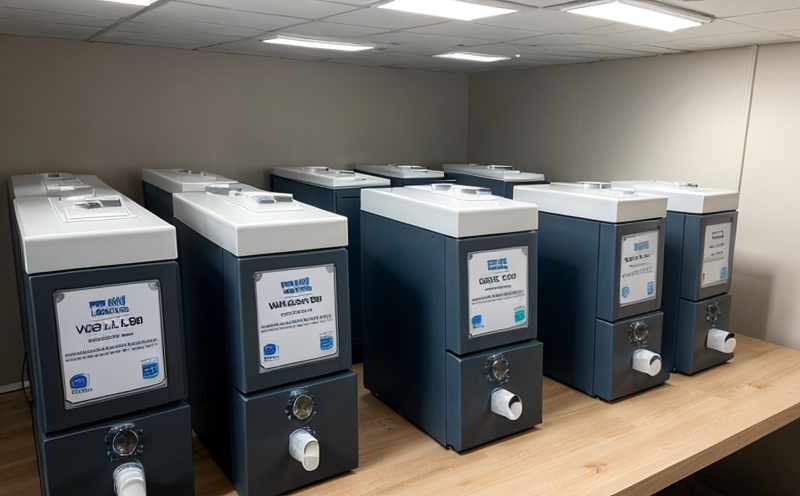NF EN ISO 16000-3 Indoor air Formaldehyde and carbonyl compound testing
Formaldehyde is a volatile chemical that can be found in various indoor environments, including textiles, furniture, carpets, and paints. It is known for its irritating effects on the respiratory system and is classified as a carcinogen by several health organizations. The NF EN ISO 16000-3 standard provides a robust framework to measure formaldehyde levels in indoor air, ensuring compliance with international standards.
The testing process involves the collection of samples from the target environment using appropriate sampling methods. These samples are then analyzed for formaldehyde and carbonyl compounds through precise instrumental techniques. The NF EN ISO 16000-3 method is particularly effective because it can detect low levels of these harmful substances, providing valuable data to assess air quality.
The test protocol includes several key steps: sample collection, transportation, storage, preparation for analysis, and actual measurement using analytical instruments such as gas chromatography. The accuracy and reliability of the results depend on strict adherence to this procedure. This method is not only used in manufacturing but also in residential and commercial settings where indoor air quality is a concern.
The NF EN ISO 16000-3 standard ensures that testing laboratories maintain high levels of expertise, precision, and integrity. Compliance with these standards is crucial for manufacturers to ensure their products do not release harmful formaldehyde into the environment. By adhering to this protocol, companies can demonstrate their commitment to environmental responsibility.
Moreover, NF EN ISO 16000-3 testing is essential in areas where air quality regulations are stringent. This includes offices, hospitals, schools, and any other public spaces that require continuous monitoring of indoor air pollutants. The test results help facilities maintain a safe and healthy environment for occupants.
Given the importance of accurate and reliable formaldehyde measurement, NF EN ISO 16000-3 is widely recognized in several countries, including Europe, the United States, and Asia. This international acceptance underscores its reliability and validity in assessing indoor air quality.
Why It Matters
The significance of formaldehyde testing cannot be overstated, especially given its known health risks. Formaldehyde exposure can lead to respiratory issues, allergic reactions, and even cancer. By ensuring that products meet strict formaldehyde emission standards, manufacturers help protect consumers' health.
In addition to the health implications, regulatory compliance is a critical factor for businesses operating in countries with stringent environmental laws. NF EN ISO 16000-3 provides a clear path to meeting these requirements, reducing the risk of legal penalties and reputational damage.
The testing process also aids in product development by identifying potential issues early on. For R&D engineers, this means being able to refine products to meet environmental standards more effectively. In procurement, it ensures that materials used in production are safe and comply with international regulations.
For quality managers, NF EN ISO 16000-3 testing offers a valuable tool for monitoring air quality across different environments. This helps maintain consistent product quality and meets the expectations of health-conscious consumers.
Why Choose This Test
The NF EN ISO 16000-3 test is chosen for several compelling reasons:
- Precision and Reliability: The method uses advanced instrumentation, ensuring accurate measurements of formaldehyde and carbonyl compounds.
- Compliance with Standards: It aligns perfectly with international standards, making it a preferred choice for companies aiming to comply with global regulations.
- Health Benefits: By reducing formaldehyde emissions, this test helps create healthier indoor environments, benefiting both employees and customers.
- Risk Management: Early detection of potential issues can prevent costly recalls and legal disputes.
The NF EN ISO 16000-3 test is particularly beneficial for industries where product safety and environmental responsibility are paramount. It provides peace of mind, knowing that your products meet the highest standards in formaldehyde emission testing.
International Acceptance and Recognition
- Europe: NF EN ISO 16000-3 is widely accepted in European Union countries, ensuring compliance with EU regulations on indoor air quality.
- Americas: The standard is recognized in the United States and Canada, aligning with federal and state environmental guidelines.
- Oceania: Many Australian states have adopted NF EN ISO 16000-3 as a benchmark for indoor air quality testing.
- Asia-Pacific: Several countries in the region, including Japan and South Korea, use this standard to ensure product safety and environmental compliance.
The universal acceptance of NF EN ISO 16000-3 underscores its reliability and validity. This international recognition ensures that testing results are respected across different regions, facilitating global trade and cooperation in the textile and manufacturing sectors.





